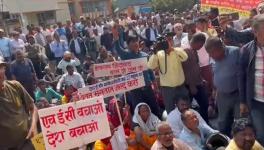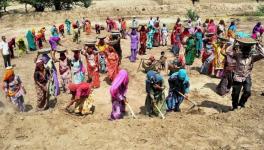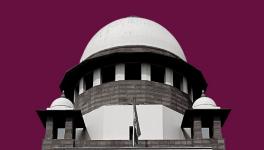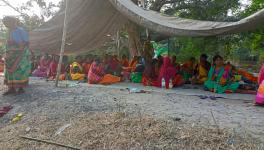Pathalgarhi Movement: In Massive Crackdown, 250 Tribals Booked Under Sedition

Newsclick Image By Nitesh Kumar
Ranchi (Jharkhand)/New Delhi: Several villages in Jharkhand’s Khunti district that resorted to Pathalgarhi – a tribal tradition of erecting stone slabs to demarcate the area of their villages’ jurisdiction, declaring their autonomy and self-rule in the areas under the Fifth Schedule of the Constitution – have virtually been fortified with round the clock police presence. As per reports, a massive police crackdown is underway on supporters of the movement – which was mired in gang-rape and abduction of five women who had gone there for an awareness programme in June last year.
Though Jharkhand Mukti Morcha (JMM) legislator Stephen Marandi has alleged that the government has lodged cases against 1,500-odd people with the aim of targeting “innocent people”, Chief Minister Raghubar Das recently negated his charges and told the Assembly that a total of 250 people had been booked in 23 separate cases of sedition and other charges and that 36 people had so far been arrested. Those who are on the run will soon be arrested, he said.
Permanent CRPF (Central Reserve Police Force) camps have been built in few villages allegedly by forceful land acquisition or on the land donated for the construction of Samudayik Bhawan (community house).
“Though the situation is limping back to normal following a series of direct confrontation between the security forces and tribals after the Pathalgarhi movement, the massive police crackdown is continuing. Hundreds of locals have been picked on false charges and police hunt for those named in the fabricated FIRs have been continuing. Evading arrest and subsequent harassment, a large number of people have fled the villages. Several villages have been turned into fortresses with the police and para military forces present round the clock,” tribal rights activist Dayamani Barla told Newsclick.
Barla said: “Permanent camps of CRPF have come up in at least five villages of the tribal-dominated Khunti district – also home to the biggest tribal icon, Birsa Munda, and the epicentre of the Pathalgarhi movement. The land for the camps was first obtained in the name of construction of community houses and later, when the villages refused to give their land realizing that CRPF camps had been built on their land, the land was acquired by picking up innocent villagers and Gram Sabha leaders and threatening them with false cases.
The tribal leader also alleged that the police was keeping a close watch on visitors and their movements. The Pathalgarhi movement supporters claim that the demands made by the movement are “legitimate” and “within the framework of the Constitution”. They argue that the legitimacy of the demands lies on Sections 13 (3), 19 (5) (6) and 244 (1) of the Fifth Schedule. They are, say the activists, in conformity with the provisions of the panchayats (Extension to Scheduled Areas) Act, 1996 or PESA – a law enacted by the Government of India for ensuring self-governance through traditional Gram Sabhas for people living in the Scheduled Areas.
The movement leaders dared the government to come up with a written statement and give an explanation of Section 13(3) and 244 (1) of the Fifth Schedule of the Constitution.
A total of 86 villages of Jharkhand’s one of the most under-developed district had taken part in the Pathalgarhi movement.
The Fifth Schedule
The Fifth Schedule of the Constitution of India, which mentions Scheduled Areas as referred to in Clause (1) of Article 244 of the Constitution, is termed as a “Constitution within a Constitution”. It talks about ensuring self-governance through traditional Gram Sabhas (self-elected village body) for people living in the Scheduled Areas; legislation on panchayats in conformity with the customary law, social and religious practices and traditional management practices of community resources; habitation or a group of habitations or a hamlet or a group of hamlets comprising a community and managing its affairs in accordance with traditions and customs and having a separate Gram Sabha.
As per the Fifth Schedule, every Gram Sabha needs to safeguard and preserve the traditions and customs of people, their cultural identity, community resources and the customary mode of dispute resolution; the Gram Sabhas have roles and responsibilities in approving all development works in the village, identify beneficiaries, issue certificates of utilization of funds; powers to control institutions and functionaries in all social sectors and local plans; and Gram Sabhas or panchayats at appropriate level shall also have powers to manage minor water bodies; power of mandatory consultation in matters of land acquisition; resettlement and rehabilitation and prospecting licenses/mining leases for minor minerals; power to prevent alienation of land and restore alienated land; regulate and restrict sale/consumption of liquor; manage village markets, control money lending to STs; and ownership of minor forest produce..
Scheduled Areas are found in 10 states of India which have predominant population of tribal communities.
When the villages resorted to Pathalgarhi, big stone slabs were erected to demarcate the area of their villages’ jurisdiction. It was declared on the slabs that outsiders – including the police and administrative officials – were barred from entering the village.
Also no one – including the government – can acquire land or sell it without seeking permission of the Gram Sabha, while the locals can draft their own rules to save the tribal culture.
“The Pathalgarhi movement has been intentionally misinterpreted to snatch away its constitutional sanctity. The declarations were taken in literal sense. Barring outsiders from entering the villages don’t mean that there is a restriction of their entry or movement in the villages. It means that no outsiders – be it administrative officials – can interfere in the affairs of the villages. And this is in line with the PESA. In fact, the legitimate demand of Adivasi autonomy has met strong resistance from the government and that is unconstitutional,” said Barla.
She went on to allege that the police and the government intentionally linked the movement with the gang-rape so that it loses support from different quarters. “The movement is treated as if it demands two separate Constitutions. In fact, we want that provisions in the Indian Constitution be followed,” she said.
Lashing out at the police for “defaming” them, Pathalgarhi supporters have announced through Gram Sabhas that they would not cooperate the police investigation. “We are being shown in poor light by the police. They distort the facts and continue to level allegations against us. Therefore, we are not going to cooperate with their investigations,” a Gram Sabha member told Newsclick requesting anonymity.
The Legal Sanctity of Pathalgarhi
Explaining the legalities surrounding the movement, noted constitutional expert Subhash C Kashyap – former secretary general of the Lok Sabha – said Pathalgarhi was “legitimate”. But, he said, the path chosen for the movement was a little problematic.
“The demand for empowering Gram Sabhas was well within the Constitution’s provisions. But if the Gram Sabhas try to reject the Assembly of the Lok Sabha, it would defeat the purpose of the Constitution,” he added.
With regard to the use of force by the state to control the movement, he said, “The attempt to curb it using police force might have met success, yet the problem remains unsolved. The problem is that the colonial system still persists. The only difference is that white sahibs have been replaced by our sahibs,” he said.
The Governor is the custodian of tribal rights and is supposed to make decisions in consultation with the Tribes Advisory Council. But unfortunately, Jharkhand, having one of the largest tribal populations, does not so far have Tribal Affairs Ministry.
On the declaring laying stone slabs to declare autonomy as illegal, Kashyap said: “Pathalgarhi is part of tribal tradition and that cannot be denied. But should it be inscribed on slabs?”
At the same time, he said selective quotes from the Constitution to deprive others from their sovereign rights is also unconstitutional. The PESA Act was aimed at recognising tribal governance but no law can be implemented till rules are framed. Most of the states have not formulated rules and regulations for tribals. Therefore, they are unable to implement the Act in the absence of rules and regulations. Even Supreme Court judgements in this regard have been ignored by successive state governments,” Kashyap added.
He cited the 1997 Samatha judgement that gave mining rights to tribals and the 2013 verdict in the Niyamgiri case. “Unfortunately, mining still continues in the Fifth Schedule areas despite these judgements,” he noted.
Explaining the tradition of Pathalgarhi, Barla said, “There is a tradition and history of Pathalgarhi among tribals belonging to the Munda tribe. However, when these villages began practicing the ancient tradition, the police started to inquire them as it’s an anti-national activity, forcing the villagers to take the cops hostages.”
The tribal leader further claimed that what tribes the were doing was not unconstitutional. “It has been a practice among tribals to inscribe the constitutional powers given to them under PESA Act on stone slabs and install them on village borders,” she added.
Why Movements Like Pathalgarhi Are Needed?
Explaining the resurgence of the ancient practice, Barla said: “The laws made for the betterment of tribals have not been implemented as they should have been. Hence, not much change has been observed in the lives of under-privileged tribals. On the other side, their properties and resources are being exploited. Be it the CNT (attempts to amend it has been made) or the PESA or the Forest Rights Act, none have been implemented in its true sense. In fact, not even eight pattas have been issued in the past 12 years of the implementation of Forest Rights Act nor have any Gram Sabha been formed or entrusted with any power. Hence, these consistent failures forced tribals to go for Pathalgarhi.
Communist Party of India ( Marxist-Leninist) leader Vinod Singh also maintains that the Pathalgarhi movement has “no problem” and is “completely legitimate”. “The government must stop the ongoing crackdown as it would worsen the situation. If it wants to resolve the issue, it must follow the route of negotiations and tactful dealings,” he added.
BJP’s Problematic Stand
The Bharatiya Janata Party (BJP) government in Jharkhand seems to have “double standards” when it comes to dealing with the Pathalgarhi movement. While Chief Minister M Raghubar Das is dead against the movement, as he recently told the Assembly that his government was not ready to accept a “wrong interpretation” of Constitution in the name of tradition and that all those behind Pathalgarhi would be brought to book, former Chhattisgarh CM Raman Singh was backing the movement in his state. He had even stated Pathalgarhi was being done in accordance with the Constitution.
Activists see an agenda when it comes to the way the ancient movement is being treated in Chhattisgarh. “The then BJP government in Chhattisgarh supported Pathalgarhi when the officials found the movement helpful in containing Christian missionaries. The government initially had blamed the missionaries for instigating Pathalgarhi; however, they later – in some areas – they used it as a means to stop Christianns from entering tribal areas,” they added.
Get the latest reports & analysis with people's perspective on Protests, movements & deep analytical videos, discussions of the current affairs in your Telegram app. Subscribe to NewsClick's Telegram channel & get Real-Time updates on stories, as they get published on our website.
























